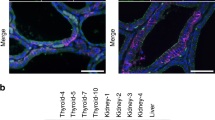Abstract
Permanent congenital hypothyroidism (CH) is a common disease that occurs in 1 of 3,000–4,000 newborns. Except in rare cases due to hypothalamic or pituitary defects, CH is characterized by elevated levels of thyroid-stimulating hormone (TSH) resulting from reduced thyroid function. When thyroid hormone therapy is not initiated within the first two months of life, CH can cause severe neurological, mental and motor damage1,2. In 80–85% of cases, CH is associated with and presumably is a consequence of thyroid dysgenesis (TD). In these cases, the thyroid gland can be absent (agenesis, 35–40%), ectopically located (30–45%) and/or severely reduced in size (hypoplasia, 5%). Familial cases of TD are rare, even though ectopic or absent thyroid has been occasionally observed in siblings3. The pathogenesis of TD is still largely unknown. Although a genetic component has been suggested, mutations in the gene encoding the receptor for the thyroid-stimulating hormone (TSHR) have been identified in only two cases of TD with hypoplasia4,5. We report mutations in the coding region of PAX8 in two sporadic patients and one familial case of TD. All three point mutations are located in the paired domain of PAX8 and result in severe reduction of the DMA-binding activity of this transcription factor. These genetic alterations implicate PAX8 in the pathogenesis of TD and in normal thyroid development.
This is a preview of subscription content, access via your institution
Access options
Subscribe to this journal
Receive 12 print issues and online access
$209.00 per year
only $17.42 per issue
Buy this article
- Purchase on Springer Link
- Instant access to full article PDF
Prices may be subject to local taxes which are calculated during checkout
Similar content being viewed by others
References
Glorieux, J. et al. Follow up at age 5 and 7 years on mental development in children with hypothyroidism detected by the Quebec screening program. J. Pediatr. 107, 913–915 (1987).
Rovet, J. & Ehrlich, R. Long term effects of L-thyroxine treatment for congenital hypothyroidism. J. Pediatr. 126, 380–386 (1995).
McKusick, V.A. Mendelian Inheritance in Man. Catalogs of Human Genes and Genetic Disorders. (Johns Hopkins University Press, Baltimore, 1994).
Abramowicz, M.J., Duprez, L., Parma, J., Vassart, G. & Heinrichs, C. Familial congenital hypothyroidism due to inactivating mutation of the thyrotropin receptor causing profound hypoplasia of the thyroid gland. J. Clin. Invest. 99, 3018–3024 (1997).
Biebermann, H. et al. Mutations of the human thyrotropin receptor gene causing thyroid hypoplasia and persistent congenital hypothyroidism. J. Clin. Endocrinol. Metab. 82, 3471–3480 (1997).
Stuart, E.T. & Gruss, P. PAX genes: what's new in developmental biology and cancer? Hum. Mol. Genet. 4, 1717–1720 (1995).
Plachov, D. et al. Pax-8, a murine paired box gene expressed in the developing excretory system and thyroid gland. Development 110, 643–651 (1990).
Zannini, M., Francis-Lang, H., Plachov, D. & Di Lauro, R. Pax-8, a paired domain-containing protein, binds to a sequence overlapping the recognition site of a homeodomain and activates transcription from two thyroid specific promoters. Mol. Cell. Biol. 12, 4230–4241 (1992).
Stapleton, P., Weith, A., Urbanek, P., Kozmik, Z. & Busslinger, M. Chromosomal localization of seven PAX genes and cloning of a novel family member, PAX-9. Nature Genet. 3, 292–298 (1993).
Kozmik, Z., Kurzbauer, R., Dörfler, P. & Busslinger, M. Alternative splicing of Pax-8 gene transcripts is developmentally regulated and generates isoforms with different binding properties. Mol. Cell. Biol. 13, 6024–6035 (1993).
Poleev, A. et al. Distinct functional properties of three human paired-box-protein, PAX8, isoforms generated by alternative splicing in thyroid, kidney and Wilms' tumor. Eur. J. Biochem. 228, 899–911 (1995).
Adams, B. et al. Pax-5 encodes the transcription factor BSAP and is expressed in B lymphocytes, the developing CNS, and adult testis. Genes Dev. 6, 1589–1607 (1992).
Xu, W., Rould, M.A., Jun, S., Desplan, C. & Pabo, C.O. Crystal structure of a paired domain-DNA complex at 2.5 Å resolution reveals structural basis for Pax developmental mutations. Cell 80, 639–650 (1995).
Rossi, D., Acebron, A. & Santisteban, P. Function of the homeo and paired domain proteins TTF-1 and Pax8 in thyroid cell proliferation. J. Biol. Chem. 270, 23139–23142 (1995).
Mansouri, A., Chowduri, K. & Gruss, P. Follicular cells of the thyroid gland require Pax8 gene function. Nature Genet. 19, 87–90 (1998).
Strachan, T. & Read, A.P. PAX genes. Curr. Opin. Genet. Dev. 4, 427–38 (1994).
Dussault, J.H. et al. Preliminary report on a mass screening program for neonatal hypothyroidism. J. Pediatr. 86, 670–674 (1975).
Grüters, A. Screening for congenital hypothyroidism-effectiveness and clinical outcome. Bailliere Clin. Paediatr. 4, 1–18 (1996).
Francis-Lang, H., Price, M., Polycarpou-Schwartz, M. & Di Lauro, R. Expression of the Rat Thyroperoxidase Promoter Indicates Common Mechanisms for Thyroid-Specific Gene Expression. Mol. Cell. Biol. 12, 576–588 (1992).
Czerny, T., Schaffner, G. & Busslinger, M. DNA sequence recognition by Pax proteins: bipartite structure of the paired domain and its binding site. Genes Dev. 7, 2048–2061 (1993).
Author information
Authors and Affiliations
Rights and permissions
About this article
Cite this article
Macchia, P., Lapi, P., Krude, H. et al. PAX8 mutations associated with congenital hypothyroidism caused by thyroid dysgenesis. Nat Genet 19, 83–86 (1998). https://doi.org/10.1038/ng0598-83
Received:
Accepted:
Issue Date:
DOI: https://doi.org/10.1038/ng0598-83
This article is cited by
-
GLIS3 expression in the thyroid gland in relation to TSH signaling and regulation of gene expression
Cellular and Molecular Life Sciences (2024)
-
Characterization of the genomic alterations in poorly differentiated thyroid cancer
Scientific Reports (2023)
-
Association of LncRNA-PAX8-AS1 and LAIR-2 polymorphisms along with their expression with clinical and subclinical hypothyroidism
Scientific Reports (2023)
-
A genotype-first analysis in a cohort of Mullerian anomaly
Journal of Human Genetics (2022)
-
Compound heterozygous GLI3 variants in siblings with thyroid hemiagenesis
Endocrine (2021)



